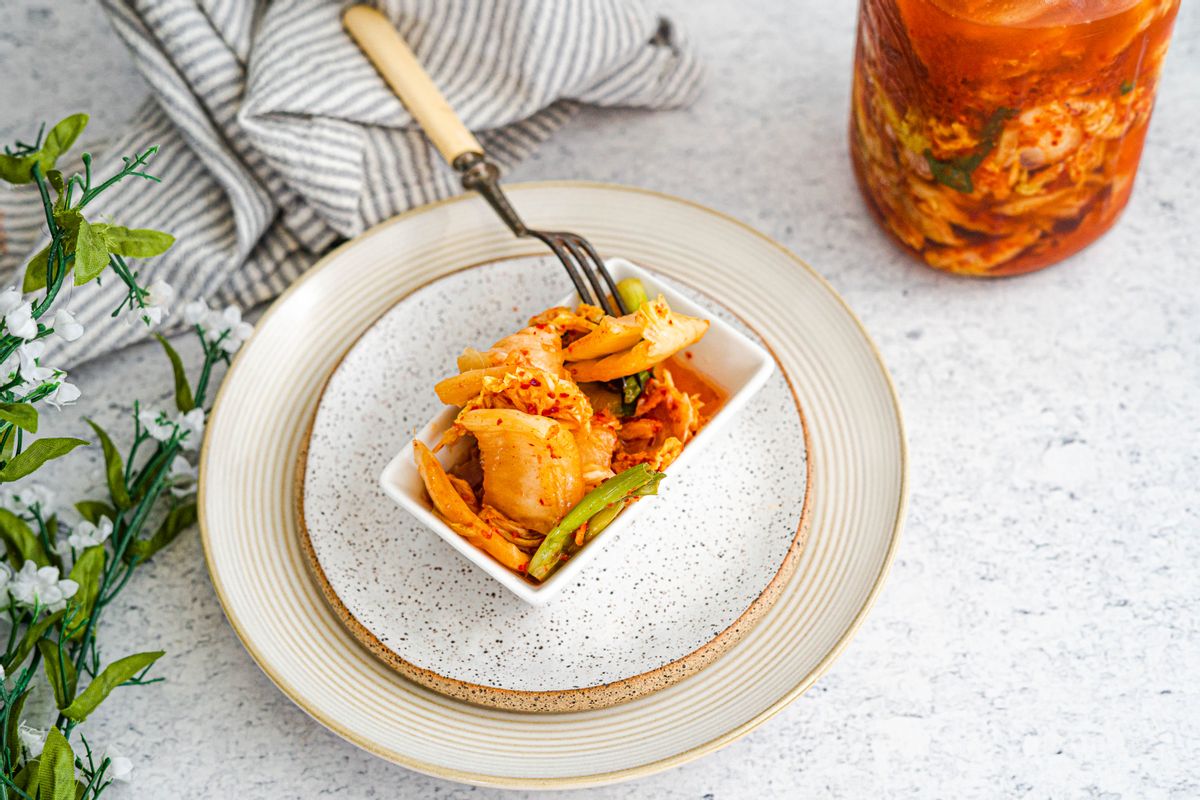
#1 Low Carb & Keto Diet App Since 2010
Track macros, calories, and access top Keto recipes.
prep time
40 min
cook time
0 min
ready time
40 min
Keto Kimchi
You will love this famous fermented cabbage that we have turned into a Keto-friendly recipe. Traditional recipes call for glutinous rice flour, which adds viscosity to the cabbage. Fortunately, this ingredient can be omitted and still create a delicious Keto ferment. To make this kimchi, we placed napa cabbage in a bowl overnight with plenty of salt and covered it with water. The next day, the cabbage is removed from the brine and squeezed of excess liquid. Then, the cabbage is massaged with gochugaru (Korean chili flakes), fish sauce, ginger, and garlic paste. The entire mixture smells wonderful! Finally, glass jars are packed with spicy cabbage and topped with any leftover brine. Feel free to add daikon radish or even carrots for color and flavor. The jars are left to ferment for 3-5 days at room temperature until effervescent. The remaining fermentation time is done in the fridge until the kimchi is spicy, tangy, and salty. You will love this Keto kimchi, a great, healthy addition to your diet.
What is the best cabbage to use?
Napa cabbage is the best cabbage to use for this kimchi. The rippled leaves are excellent at holding the spicy gochugaru paste and are the traditional cabbage for kimchi.
Where can I find gochugaru flakes?
Gochugaru flakes can be found at your local Asian or Korean grocery store. If you cannot source them easily, large online retailers will carry them. These kinds of flakes are different than red chili flakes. The spice is different in that it contains no seeds and is fruity in flavor. Gochugaru is also not as spicy as red chili flakes. They are around 7x less spicy, but what they lack in the heat makes up for in flavor!
Do I have to use fish sauce?
No, if you do not like the fish sauce, you can omit it. However, this is part of what gives kimchi its distinctive authentic flavor.
Is kimchi Keto?
Yes! Kimchi can be Keto-friendly and it is full of probiotics and prebiotics for a happy and healthy gut! Cabbage and gochugaru flakes are Low Carb in nature, so the ingredients lend themselves well to a Keto lifestyle. Just be sure to avoid store-bought Kimchi containing rice flour.
To make the ultimate pairing, serve kimchi as a side dish to other Keto Korean recipes like our Keto Korean BBQ Chicken Thighs! One of our favorite recipes!
Net Carbs
2.8 g
Fiber
1 g
Total Carbs
3.9 g
Protein
0.9 g
Fats
0.1 g
19 cals

#1 Low Carb & Keto Diet App Since 2010
Track macros, calories, and access top Keto recipes.
Ingredients
Napa cabbage
2 lb
Coarse Kosher Salt
0.25 cup
Fish sauce (nam pla or nuoc mam)
4 tbsp
Gochugaru Korean Red Hot Chili Pepper Flakes
5 tbsp
Garlic
8 clove
Ginger
2 tbsp
Scallions
4 medium - 4 1/8" long
Recipe Steps
steps 7
40 min
Step 1
Wash the napa cabbage leaves well. Reserve one leaf. Then place the cabbage on a cutting board. Slice the cabbage down the middle vertically without going all the way to the end of the cabbage. Turn the cabbage 90 degrees and repeat this process. Then cut the cabbage horizontally into 1" pieces. Place the cabbage in a very large bowl. Sprinkle the cabbage with a heaped ¼ cup of kosher salt. Next, top the cabbage with water until it is all submerged. Allow the cabbage to sit overnight, covered with plastic wrap.Step 2
Next, make the spicy paste. Combine the fish sauce, gochugaru flakes, garlic cloves, and minced ginger together. Pulse the mixture in a small food processor or with a stick blender until a thick paste has formed. You can make this mixture a day ahead of time.Step 3
The next day, remove the cabbage from the brine and squeeze out as much water from the cabbage as possible back into the brine liquid. Place the squeezed cabbage into a medium-sized mixing bowl. Add in the scallions which have been cut into 1” pieces.Step 4
Add in the spicy paste. Massage the paste all over the leaves. Place the leaves divided into two quart-sized mason jars. Press the leaves down well.Step 5
Top the cabbage with the brine mixture until they are completely submerged. Take the previously reserved leaf and divide it in half. Use this leaf to press the mixture into the jar to keep everything submerged in the brine.Step 6
Allow the kimchi to sit at room temperature in a dark, cool room for 3-5 days or until you see really good action starting (lots of bubbles). The length of time might take longer if your room is particularly cold. You should open the jar every couple of days to ensure the cabbage is still under the liquid; if not, press it down with a clean utensil.Step 7
You can keep the jars on top of a plate to keep any liquid that rises out contained. The kimchi will still be salty at this point and just starting to get sour. Then, place it in the refrigerator to continue fermenting until the right flavor develops for your taste. You can refrigerate kimchi for up to one year and will continue to ferment more slowly in the refrigerator.




















